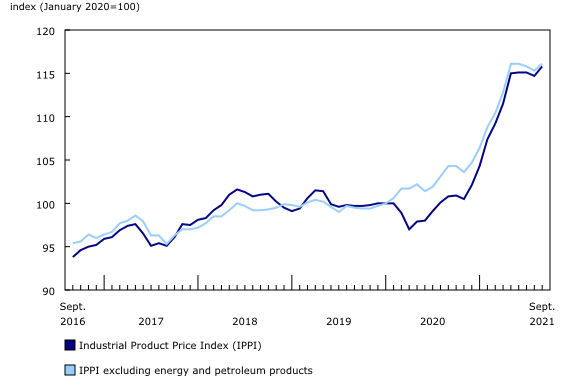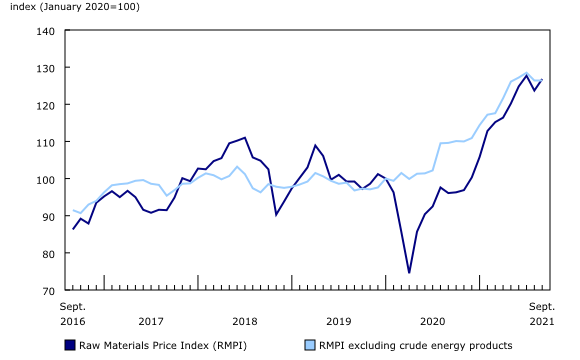Industrial product and raw materials price indexes, September 2021
Archived Content
Information identified as archived is provided for reference, research or recordkeeping purposes. It is not subject to the Government of Canada Web Standards and has not been altered or updated since it was archived. Please "contact us" to request a format other than those available.
Released: 2021-10-29
The price of products manufactured in Canada, as measured by the Industrial Product Price Index (IPPI), increased 1.0% month over month in September and 14.9% compared with the same month in 2020. Prices of raw materials purchased by manufacturers operating in Canada, as measured by the Raw Materials Price Index (RMPI), increased 2.5% month over month in September and 31.9% compared with September 2020.
Industrial Product Price Index
In September, the IPPI increased 1.0% after decreasing 0.3% the previous month. Of the 21 major commodity groups, 14 were up, 5 were down, and 2 were unchanged.
The growth in the IPPI was mainly attributable to increases in prices for energy and petroleum products (+3.8%). Widespread price increases for refined petroleum products, particularly diesel and biodiesel fuels (+7.7%), were mainly responsible for the gains in energy and petroleum products. Prices for light fuel oils (+8.1%) and aviation fuel (+5.4%) also contributed to the increase, but to a lesser extent. The prices of refined petroleum products partly reflect the rise in crude oil prices.
Prices for chemicals and chemical products were up 1.8% in September, following a 1.3% increase in August. This growth was mainly attributable to an increase in prices for ammonia and chemical fertilizers (+10.7%) as well as petrochemicals (+4.0%). Limited supply of crude oil and natural gas, combined with temporary closures of some production sites in the United States after various storms passed through the Gulf of Mexico area, was largely behind the increase in prices for fertilizers and petrochemicals.
Primary ferrous metal products increased 1.7%, driven up mainly by prices of basic and semi-finished iron or steel products (+1.7%), particularly hot-rolled iron or steel products (+2.6%). The price of steel was pushed upward by ongoing strong demand and restricted supply, compounded by limited production at steel mills in China.
Prices for motorized and recreational vehicles (+0.6%) also rose in September compared with August, largely because of the increase in prices for medium and heavy trucks, buses, and other motor vehicles (+3.5%), aircraft (+2.0%), and boats and other transportation equipment (+3.0%).
Fabricated metal products and construction materials (+2.6%) and plastic and rubber products (+3.6%) were also among the product groups that posted higher prices in September.
The IPPI's growth was mainly moderated by a decline in prices for lumber and other wood products (-1.3%). Lower prices for veneer and plywood (-10.3%), softwood lumber (-0.7%), and reconstituted wood products (-1.7%) were the main contributors to the decline in this product group.
Raw Materials Price Index
The RMPI increased 2.5% in September after decreasing 3.1% in August. Of the six major commodity groups, two were up and four were down.
Crude energy products were the main source of the RMPI's growth in September, with prices rising 7.2%, after decreasing 5.8% the previous month. This gain was mainly due to higher prices for conventional crude oil (+7.3%) and synthetic crude oil (+6.3%). Natural gas prices (+6.7%) also contributed to the increase, but to a lesser extent. The oil market was driven upward by several factors, including increased global demand for oil, the ongoing production limits by the Organization of the Petroleum Exporting Countries Plus (OPEC+) and the slow recovery of production on the US Gulf Coast after Hurricane Ida moved through the area in late August.
Prices for crop products (+2.5%) were also up from August. In this group, prices for grains (except wheat) increased 10.8%, a sixth consecutive monthly gain and the highest increase since July 2012 (+13.0%).
Prices for logs, pulpwood, natural rubber and other forestry products (-2.6%) and for animals and animal products (-0.7%) decreased compared with August. In the first group, the decline was mainly due to lower prices for logs and bolts (-2.8%). The decline in prices for animals and animal products was largely attributable to lower prices for hogs (-8.9%).
Compared with September 2020, the RMPI rose 31.9%, driven upward mainly by prices of conventional crude oil (+79.2%), synthetic crude oil (+77.6%) and canola (+76.6%).
Note to readers
The Industrial Product Price Index (IPPI) and the Raw Materials Price Index (RMPI) are available at the Canada level only. Selected commodity groups within the IPPI are also available by region.
With each release, data for the previous six months may have been revised. The indexes are not seasonally adjusted.
The Industrial Product Price Index reflects the prices that producers in Canada receive as goods leave the plant gate. The IPPI does not reflect what the consumer pays. Unlike the Consumer Price Index, the IPPI excludes indirect taxes and all costs that occur between the time a good leaves the plant and the time the final user takes possession of the good. This includes transportation, wholesale and retail costs.
Canadian producers export many goods. They often indicate their prices in foreign currencies, especially in US dollars, and these prices are then converted into Canadian dollars. This is particularly the case for motor vehicles, pulp and paper products, and wood products. Therefore, fluctuations in the value of the Canadian dollar against its US counterpart affect the IPPI. However, the conversion to Canadian dollars reflects only how respondents provide their prices. This is not a measure that takes into account the full effect of exchange rates.
The conversion of prices received in US dollars is based on the average monthly exchange rate established by the Bank of Canada and available in Table 33-10-0163-01 (series v111666275). Monthly and annual variations in the exchange rate, as described in the release, are calculated according to the indirect quotation of the exchange rate (for example, CAN$1 = US$X).
The Raw Materials Price Index reflects the prices paid by Canadian manufacturers for key raw materials. Many of those prices are set on the world market. However, as few prices are denominated in foreign currencies, their conversion into Canadian dollars has only a minor effect on the calculation of the RMPI.
Products
Statistics Canada launched the Producer Price Indexes Portal as part of a suite of portals for prices and price indexes. This web page provides Canadians with a single point of access to a variety of statistics and measures related to producer prices.
The video "Producer Price Indexes" is available on the Statistics Canada Training Institute web page. It provides an introduction to Statistics Canada's producer price indexes—what they are, how they are made, and what they are used for.
Next release
The industrial product and raw materials price indexes for October 2021 will be released on November 29, 2021.
Contact information
For more information, or to enquire about the concepts, methods, or data quality of this release, contact us (toll-free 1-800-263-1136; 514-283-8300; STATCAN.infostats-infostats.STATCAN@statcan.gc.ca) or Media Relations (613-951-4636; STATCAN.mediahotline-ligneinfomedias.STATCAN@statcan.gc.ca).
- Date modified:




